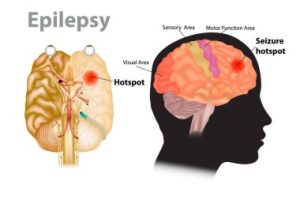
Can Epilepsy People Exercise And Play Sports (3 Helpful Exercises)
Can epilepsy people exercise and play sports without compromising their health? Engaging in physical activity may offer not only physical benefits but also potential improvements in seizure control and overall well-being for individuals with epilepsy. Understanding the relationship between exercise and epilepsy is crucial for promoting a healthy and active lifestyle in this population.
In the dynamic symphony of life, the rhythm of movement often collides with the unpredictable cadence of health challenges. Amidst this intricate dance, individuals navigating the intricate realm of epilepsy find themselves questioning the harmonious fusion of exercise and sports within their lives.
Can epilepsy coexist with the adrenaline-fueled exhilaration of physical activity? The answer is not a simple binary, but a captivating exploration into the resilience of the human spirit, the power of adaptation, and the triumph of individuals determined to seize every beat of life, even in the face of epilepsy. Join to unravel the enigma of whether epilepsy and the pursuit of fitness can engage in a synchronized dance or if they are destined to exist in opposing realms.

Can Epilepsy People Exercise And Play Sports
Yes, individuals with epilepsy can participate in exercise and sports with proper precautions and guidance from healthcare professionals.
Living with epilepsy does not mean giving up on an active lifestyle. Many people wonder about the compatibility of exercise and sports with epilepsy, and it’s essential to understand that, with careful considerations, individuals with epilepsy can engage in physical activities that contribute to their overall well-being.
Benefits of Exercise for People with Epilepsy
Regular exercise has numerous physical and mental health benefits for individuals with epilepsy. Engaging in physical activity helps manage stress, improves mood, and promotes better sleep – all factors that can positively impact seizure control. It also aids in maintaining a healthy weight, which is crucial since certain medications can lead to weight gain.
Precautions and Safety Measures
Before starting any exercise regimen or participating in sports, it’s vital for individuals with epilepsy to consult with their healthcare team. The healthcare provider can offer personalized advice based on the individual’s specific condition and potential triggers. It’s recommended to choose activities with a lower risk of injury, have a consistent routine, and be mindful of factors like hydration and sleep.
Common Concerns Addressed
People often express concerns about the potential risk of seizures during physical activities. However, with proper precautions and understanding of personal triggers, the risk can be minimized. It’s crucial to communicate openly with coaches, teammates, and fitness instructors about one’s condition to ensure a supportive and safe environment.
Understanding Epilepsy and Exercise
General considerations
Importance of regular exercise for overall health
Regular exercise is crucial for maintaining overall health and well-being. Engaging in physical activity helps improve cardiovascular health, manage weight, and boost mood. For individuals with epilepsy, exercise plays a vital role in stress reduction and enhancing quality of life.
Common misconceptions about epilepsy and physical activity
Despite its importance, there are misconceptions surrounding exercise and epilepsy. Many wrongly believe that individuals with epilepsy should avoid physical activity altogether. In reality, with proper precautions and guidance, most people with epilepsy can safely participate in a wide range of exercises.
Types of epilepsy
Focal seizures
Focal seizures, also known as partial seizures originate in a specific area of the brain. The impact of focal seizures on exercise can vary, but it’s essential for individuals to understand their seizure triggers and adapt their workout routines accordingly. Consultation with a healthcare professional can provide personalized recommendations.
Generalized seizures
Generalized seizures affect the entire brain and can lead to loss of consciousness. Managing exercise with generalized seizures involves focusing on activities with a lower risk of injury, such as swimming or walking. Individuals with generalized seizures should prioritize activities that minimize the risk of injury during episodes.
Absence seizures
Absence seizures characterized by brief lapses in awareness, may not significantly impact exercise. However, individuals experiencing absence seizures should still exercise caution during activities that require sustained attention. Opting for exercises with shorter durations and frequent breaks can be beneficial.
How different types may impact exercise choices
Tailoring exercise choices based on the type of epilepsy is crucial. Understanding the specific challenges associated with focal, generalized, or absence seizures allows individuals to make informed decisions about the intensity, duration, and type of physical activity that best suits their condition.

Benefits of Exercise for People with Epilepsy
Physical Benefits
Cardiovascular Health
Engaging in regular exercise significantly contributes to improved cardiovascular health for individuals with epilepsy. Aerobic activities, such as brisk walking or cycling, enhance blood circulation and strengthen the heart, promoting overall cardiovascular well-being. Incorporating these exercises into a routine can aid in reducing the risk of heart-related complications associated with epilepsy.
Muscle Strength and Flexibility
Exercise plays a crucial role in enhancing muscle strength and flexibility, benefiting individuals with epilepsy by promoting better overall physical function. Strength training exercises, combined with stretching routines, contribute to increased muscle tone and flexibility, supporting improved mobility and reducing the risk of injuries.
Weight Management
Regular physical activity aids in weight management for individuals with epilepsy, helping to maintain a healthy body weight. This is particularly crucial, as excess weight can sometimes exacerbate certain epilepsy-related challenges. Incorporating exercises that focus on calorie expenditure contributes to achieving and sustaining a healthy weight.
Psychological Benefits
Stress Reduction
Exercise serves as a powerful stress management tool for individuals with epilepsy. Engaging in activities such as yoga or mindfulness-based exercises can alleviate stress levels, promoting a sense of calmness and balance. This holistic approach positively impacts overall well-being, complementing medical interventions for epilepsy.
Improved Mood and Mental Well-being
Regular physical activity is linked to improved mood and mental well-being for individuals with epilepsy. Endorphin release during exercise contributes to a more positive emotional state, offering a natural and accessible means of combating feelings of anxiety or depression often associated with epilepsy.
Enhanced Cognitive Function
Exercise plays a pivotal role in enhancing cognitive function for individuals with epilepsy. Cognitive exercises, combined with physical activity, stimulate brain function and may contribute to improved focus, memory, and overall cognitive abilities, providing comprehensive support for those managing epilepsy.
By incorporating these exercise-related activities into a routine, individuals with epilepsy can reap the numerous physical and psychological benefits that contribute to an improved quality of life. Regular cardiovascular exercise, muscle-strengthening routines, stress-reducing activities, and cognitive exercises collectively form a holistic approach to epilepsy management.
Considerations Before Starting an Exercise Program
Medical consultation
Importance of consulting with healthcare professionals
Before embarking on any exercise program, it is crucial to prioritize a medical consultation. This ensures a comprehensive understanding of individual health needs and minimizes potential risks. Seeking guidance from healthcare professionals, such as neurologists, can help tailor exercise plans to specific conditions like epilepsy. This step is pivotal in creating a safe and effective fitness regimen, promoting overall well-being.
Discussion of individual seizure triggers and patterns
Engaging in a thorough dialogue about personal seizure triggers and patterns is integral to crafting a suitable exercise plan. Healthcare providers can offer insights into activities that may exacerbate seizures, allowing for the customization of workout routines. This personalized approach enhances safety and addresses individual concerns, fostering confidence in the fitness journey.
Medication management
Impact of antiepileptic drugs on physical activity
Understanding the impact of antiepileptic drugs (AEDs) on physical activity is vital for individuals managing epilepsy. Healthcare consultations should include discussions about potential side effects affecting energy levels, coordination, or balance. This knowledge empowers individuals to choose exercises that align with their medication regimen, optimizing the overall exercise experience.
Adjusting medication schedules around exercise
It is essential to consider the timing of medication in relation to exercise to maximize effectiveness and minimize risks. Collaborating with healthcare professionals can lead to personalized strategies, ensuring that medication schedules complement the workout routine. This proactive approach contributes to a more consistent and successful exercise program for individuals managing epilepsy.
Safe and Suitable Exercises for People with Epilepsy
Engaging in regular physical activity is crucial for maintaining overall health and well-being, even for individuals living with epilepsy. When considering exercise options, it is essential to prioritize safety and suitability to minimize the risk of triggering seizures. Here, various types of exercises tailored for people with epilepsy, highlighting their benefits and safety precautions.
Aerobic exercises
Walking
Walking is a low-impact aerobic exercise that enhances cardiovascular health without imposing excessive strain on the body. Incorporating daily walks into one’s routine can promote physical fitness and overall well-being for individuals with epilepsy. It’s important to start gradually and choose safe, open environments to prevent injury.
Jogging/running
For those seeking more vigorous aerobic activities, jogging or running can be suitable with proper precautions. Gradual progression, consistent hydration, and being mindful of triggers are essential. Many individuals with epilepsy find joy and stress relief in jogging, ensuring a holistic approach to both physical and mental well-being.
Swimming
Swimming is a highly recommended exercise for individuals with epilepsy due to its low-impact nature. The buoyancy of water reduces stress on joints and muscles, making it a safe and enjoyable option. Always swim in supervised areas and inform lifeguards or companions about your condition for added safety.

Strength training
Weight lifting
Incorporating weight lifting into an exercise routine can contribute to improved strength and muscle tone. Start with lighter weights and gradually progress, avoiding overly strenuous activities. Maintaining proper form and consulting with a fitness professional familiar with epilepsy considerations is crucial for a safe strength training regimen.
Resistance training
Resistance training, using bands or body weight, offers an effective alternative for building muscle without the need for heavy weights. This approach provides flexibility in intensity, allowing individuals with epilepsy to tailor their workouts to their comfort level and capabilities.

Flexibility exercises
Yoga
Yoga is renowned for promoting flexibility, balance, and relaxation. Many individuals with epilepsy find yoga beneficial for stress management and seizure control. Choose gentle yoga practices, such as Hatha or Yin yoga, and inform the instructor about your condition for personalized modifications.
Pilates
Pilates focuses on core strength, flexibility, and overall body awareness. With its controlled movements, Pilates can be adapted for individuals with epilepsy, emphasizing mindful breathing and slow, deliberate exercises. Always communicate with the instructor about your condition to ensure a safe and customized workout experience.

Sports and Activities
Low-risk sports
Cycling
Cycling is a low-impact and cardiovascular-friendly activity that promotes overall well-being. Enthusiasts often seek lightweight bikes, helmets, and cycling gear to enhance their performance. Explore scenic routes, cycling clubs, and the joy of pedal-powered adventures.
Golf
Golf stands out as a particularly accessible and accommodating sport for individuals with epilepsy within the broader spectrum of exercise and physical activities. The low-intensity nature of the game, characterized by gentle swings, walking, and strategic gameplay, makes it well-suited for those managing epilepsy. The sport’s serene environment and unhurried pace provide an ideal setting for individuals to engage in physical activity without the heightened stress associated with more vigorous sports.
As with any physical activity, it is essential for individuals with epilepsy to consult their healthcare professionals to determine personalized guidelines and ensure a safe and enjoyable golfing experience. The adaptability of golf makes it a promising avenue for fostering an active lifestyle among those managing epilepsy, emphasizing the importance of tailored exercise options in promoting overall well-being.
Bowling
Bowling can be a suitable and enjoyable sport for individuals with epilepsy to engage in physical activity without excessive strain. The controlled and rhythmic nature of bowling movements, coupled with the supportive environment of a bowling alley, makes it a low-impact sport that minimizes the risk of injury or triggering seizures.
Additionally, the social aspect of bowling can contribute to a positive mental well-being, fostering a sense of community and camaraderie. However, it is crucial for individuals with epilepsy to consult with their healthcare professionals before participating in any physical activity, including bowling, to ensure that it aligns with their specific health needs and considerations.

Moderate-risk sports
Tennis
Tennis, a dynamic and physically demanding sport, can be a viable and enjoyable option for individuals with epilepsy who wish to engage in regular exercise. While it is essential for those with epilepsy to consult their healthcare professionals before undertaking any new physical activity, tennis offers various benefits that align with overall health goals.
The sport involves a combination of cardiovascular endurance, strength training, and improved coordination, which can contribute to enhanced fitness levels. Additionally, the social aspect of playing tennis can foster a supportive and active community, positively impacting mental well-being. With proper guidance and precautions, individuals with epilepsy can explore tennis as a fulfilling avenue for exercise and recreational participation in sports.
Soccer
Soccer, a dynamic and widely loved sport, can be a viable and enjoyable option for individuals with epilepsy who aim to engage in physical activity. While it is essential for those with epilepsy to consult with healthcare professionals before embarking on any sports endeavor, soccer’s moderate to high-intensity nature can contribute to improved cardiovascular health, enhanced coordination, and increased overall fitness.
The team-oriented nature of soccer also fosters social connections, potentially aiding in the emotional well-being of individuals with epilepsy. Proper precautions, such as awareness of personal triggers and adherence to safety guidelines, can enable those with epilepsy to participate actively in soccer, reaping the numerous physical and social benefits associated with the sport.
Basketball
In the realm of sports for individuals with epilepsy, basketball stands out as an inclusive and dynamic option. Engaging in basketball can be a beneficial form of exercise for people with epilepsy, promoting cardiovascular health, enhancing coordination, and fostering social interactions.
While it is essential for individuals with epilepsy to consult with their healthcare professionals before embarking on any physical activity, basketball’s structured nature allows for controlled movements and teamwork. Additionally, the sport’s intermittent nature may align well with the exercise recommendations for individuals with epilepsy. With proper precautions and supervision, basketball can contribute not only to physical fitness but also to the overall well-being of those living with epilepsy.

High-risk sports
Boxing
Boxing can be a contentious topic when considering exercise for individuals with epilepsy. While contact sports like boxing carry a risk of head injuries, it is essential to evaluate the potential benefits and drawbacks for each individual. Some people with epilepsy may find that non-contact forms of boxing training, focusing on footwork, coordination, and conditioning, can be enjoyable and safe.
However, it is imperative for individuals with epilepsy to consult with their healthcare professionals and coaches to assess the suitability of such activities, ensuring that safety measures are in place to minimize the risk of injury and seizures during participation.
Wrestling
Wrestling can be a challenging yet rewarding sport for individuals with epilepsy, provided that proper precautions are taken. While participation in contact sports like wrestling may raise concerns, individuals with epilepsy can still engage in this activity with careful consideration and medical guidance. It is essential for wrestlers with epilepsy to work closely with their healthcare team to assess their individual health status, seizure control, and overall fitness levels.
Coaches and teammates should also be informed about the condition to ensure a supportive and safe training environment. With proper precautions and a well-monitored training regimen, individuals with epilepsy can potentially enjoy the physical and mental benefits that wrestling and other sports offer.
Contact sports considerations
Participating in contact sports poses unique considerations for individuals with epilepsy. While exercise is generally encouraged for its numerous health benefits, those with epilepsy must approach contact sports cautiously. Rigorous physical activities and the risk of head injuries inherent in contact sports may increase the likelihood of seizures.
It is essential for individuals with epilepsy to work closely with their healthcare providers, including neurologists and sports medicine professionals, to assess the potential risks and benefits of engaging in contact sports. Implementing proper safety measures, such as wearing protective gear and closely monitoring health, becomes paramount in minimizing potential hazards while fostering an inclusive environment for individuals with epilepsy to enjoy the physical and social aspects of sports.

Precautions and Safety Measures
Exercising with a Buddy or in a Supervised Environment
Precautions and safety measures play a pivotal role in ensuring a secure and enjoyable exercise experience for individuals with epilepsy. Exercising with a buddy or in a supervised environment can provide an additional layer of protection. Having a workout partner or being under the guidance of a trained professional ensures immediate assistance in case of a seizure or any unforeseen event.
This collaborative approach not only enhances the individual’s safety but also fosters a supportive and encouraging atmosphere, promoting confidence in engaging with physical activities. Moreover, choosing activities that minimize the risk of injury and being mindful of one’s personal limitations further contribute to a safe and empowering exercise routine for people with epilepsy.
Wearing Appropriate Safety Gear
When considering exercise and sports participation for individuals with epilepsy, prioritizing safety through the use of appropriate safety gear is paramount. Wearing protective equipment such as helmets, pads, and other relevant gear can significantly reduce the risk of injury during physical activities. It is crucial for individuals with epilepsy to consult with their healthcare professionals to determine the specific safety measures and gear suitable for their condition.
Additionally, maintaining open communication with coaches, teammates, and other participants about one’s epilepsy and potential triggers can create a supportive environment, ensuring that everyone involved is aware and prepared to respond appropriately in case of an emergency. By taking these precautions and adhering to safety guidelines, individuals with epilepsy can confidently engage in exercise and sports, promoting both physical fitness and overall well-being.
Being Aware of Warning Signs and Symptoms During Exercise
When individuals with epilepsy engage in exercise and sports, it becomes imperative to be vigilant about warning signs and symptoms that may arise during physical activity. Firstly, it is crucial for them to be aware of their personal triggers and factors that may exacerbate seizures. Regular communication with healthcare professionals is essential to tailor an exercise plan that suits their specific condition.
Additionally, having a knowledgeable and trained exercise partner or coach who is aware of the person’s epilepsy and understands the appropriate responses to potential seizures is vital. Wearing identification, such as a medical alert bracelet, can also provide crucial information to bystanders in case of an emergency. Incorporating these precautions ensures a safer and more enjoyable experience for individuals with epilepsy participating in physical activities.
Emergency Action Plan
Educating exercise partners about epilepsy and potential seizures
In the context of promoting a safe environment for individuals with epilepsy to engage in physical activity, establishing an Emergency Action Plan (EAP) becomes imperative. Educating exercise partners about epilepsy and the potential occurrence of seizures is a crucial component of an effective EAP. Exercise partners should be informed about recognizing seizure symptoms, understanding the person’s specific seizure triggers, and being aware of the appropriate steps to take in case of an emergency.
This knowledge equips exercise partners with the ability to respond promptly and effectively, ensuring the well-being of individuals with epilepsy during physical activities and sports. By fostering understanding and preparedness, we can create inclusive fitness environments that empower individuals with epilepsy to lead active and fulfilling lives.
Having an emergency response plan in place
Having an emergency action plan is paramount for individuals with epilepsy participating in exercise and sports. This plan should be a comprehensive strategy outlining the necessary steps to be taken in the event of a seizure during physical activity. It involves educating coaches, teammates, and individuals themselves on recognizing seizure symptoms, ensuring a safe environment, and implementing appropriate first aid measures.
A well-designed emergency action plan not only enhances the overall safety of the sports environment but also empowers those with epilepsy to confidently engage in physical activities, knowing that there is a structured and effective response protocol in place. This proactive approach not only safeguards the well-being of individuals with epilepsy but also promotes inclusivity and accessibility in sports and exercise programs.
Carrying identification and informing others about the condition
In the context of epilepsy and engaging in physical activities like exercise and sports, having a well-thought-out Emergency Action Plan (EAP) is paramount. Individuals with epilepsy should prioritize carrying proper identification, such as a medical alert bracelet or card, that clearly communicates their condition and emergency contact information.
This simple measure ensures that in the event of a seizure during exercise or sports, bystanders and medical professionals can quickly identify the person’s medical history and take appropriate actions. Additionally, informing teammates, coaches, or exercise partners about the individual’s epilepsy and providing them with basic seizure first aid training can further enhance the effectiveness of the Emergency Action Plan, fostering a safer environment for those with epilepsy to participate in physical activities confidently.
Real-life Stories and Testimonials
Empowering Stories of Triumph Over Epilepsy through Sports and Exercise
Unlock the potential of perseverance and resilience to delve into real-life narratives of individuals triumphing over epilepsy through sports and exercise. These compelling testimonials showcase the extraordinary achievements of those who refused to let epilepsy define their limits.
Explore how these champions conquered their fears, defied stereotypes, and embraced a life filled with vitality. Discover the profound impact of physical activity on managing epilepsy and witness firsthand the strength that lies within these inspiring individuals.
Elevating Well-being: The Transformative Power of Sports and Exercise for Individuals with Epilepsy
Immerse yourself in the uplifting narratives of individuals with epilepsy whose lives have been positively transformed through sports and exercise. Uncover the holistic benefits as they share how physical activity not only aids in seizure management but also enhances their overall well-being.
These authentic testimonials illuminate the journey from vulnerability to empowerment, emphasizing the importance of an active lifestyle in fostering mental and physical resilience. Join to celebrate the profound positive impact that sports and exercise can have on the well-being of those living with epilepsy.
Frequently Asked Questions About Can Epilepsy People Exercise And Play Sports
Q: Can people with epilepsy engage in regular exercise and sports activities?
A: Yes, many individuals with epilepsy can participate in exercise and sports. However, it’s essential to consult with a healthcare professional to determine the most suitable activities based on individual circumstances.
Q: Are there specific types of exercises recommended for people with epilepsy?
A: Low-impact activities such as swimming, walking, or yoga are often recommended. However, the choice of exercise should be tailored to the individual’s health condition and seizures, with guidance from a healthcare provider.
Q: Can physical activity trigger seizures in people with epilepsy?
A: While some individuals may experience exercise-induced seizures, it’s not a universal occurrence. Understanding personal triggers and working with a healthcare team to manage them can help individuals safely enjoy physical activities.
Q: Should people with epilepsy avoid contact sports?
A: The suitability of contact sports varies among individuals. It’s crucial to assess the risks and benefits with a healthcare professional. Protective gear and close monitoring may be necessary for those participating in contact sports.
Q: How does medication impact exercise for individuals with epilepsy?
A: Some medications may affect energy levels or coordination. Working with a healthcare provider to adjust medication dosage or timing can help optimize both seizure control and the ability to engage in physical activities.
Q: Can regular exercise help in managing epilepsy?
A: Yes, maintaining a healthy lifestyle, including regular exercise, may contribute to overall well-being. It’s important to strike a balance and avoid overexertion, which could potentially trigger seizures in some cases.
Q: What precautions should be taken before starting a new exercise routine?
A: Consultation with a healthcare provider is essential to assess individual health and seizure history. Developing a tailored exercise plan, staying hydrated, and recognizing personal triggers are key components of a safe fitness routine.
Q: How should coaches or fitness instructors accommodate individuals with epilepsy?
A: Coaches and instructors should be informed about an individual’s condition and triggers. It’s crucial to have an emergency action plan, awareness of seizure first aid, and communication with the person’s healthcare team.
Q: Can participating in sports or exercise worsen epilepsy over time?
A: Generally, regular exercise is considered beneficial, but individual responses may vary. Monitoring seizures, adjusting activities accordingly, and maintaining open communication with healthcare professionals are essential for long-term well-being.
Q: Is there a specific age limit for individuals with epilepsy to engage in sports?
A: There isn’t a specific age limit. The decision to participate in sports should be based on individual health and seizure management. Children and adults can safely engage in various activities with proper guidance and precautions.
Conclusion
In conclusion, individuals with epilepsy can indeed engage in exercise and sports, provided they take necessary precautions and work closely with healthcare professionals to manage their condition. Regular physical activity has been shown to offer numerous benefits for people with epilepsy, including improved mood, reduced stress, and better overall well-being.
It is crucial, however, for individuals to choose activities that minimize the risk of injury and to communicate openly with their healthcare team to tailor a safe and effective exercise plan. With proper guidance and awareness, individuals with epilepsy can enjoy the positive impact of exercise on their physical and mental health, contributing to a fulfilling and active lifestyle.